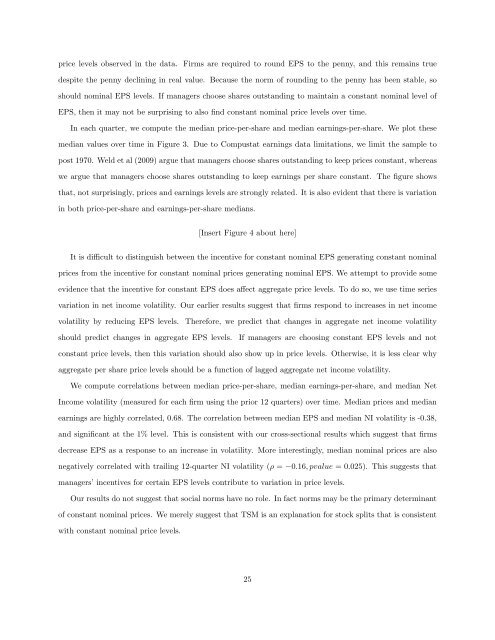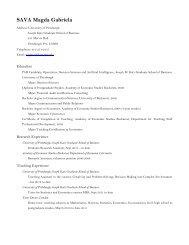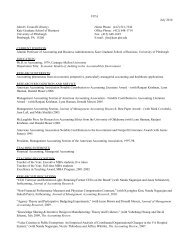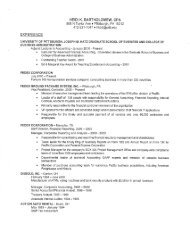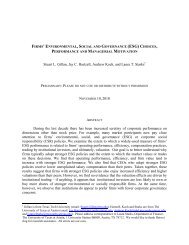Gaming the Float: How Managers Respond to EPS-based Incentives
Gaming the Float: How Managers Respond to EPS-based Incentives
Gaming the Float: How Managers Respond to EPS-based Incentives
Create successful ePaper yourself
Turn your PDF publications into a flip-book with our unique Google optimized e-Paper software.
price levels observed in <strong>the</strong> data. Firms are required <strong>to</strong> round <strong>EPS</strong> <strong>to</strong> <strong>the</strong> penny, and this remains true<br />
despite <strong>the</strong> penny declining in real value. Because <strong>the</strong> norm of rounding <strong>to</strong> <strong>the</strong> penny has been stable, so<br />
should nominal <strong>EPS</strong> levels. If managers choose shares outstanding <strong>to</strong> maintain a constant nominal level of<br />
<strong>EPS</strong>, <strong>the</strong>n it may not be surprising <strong>to</strong> also find constant nominal price levels over time.<br />
In each quarter, we compute <strong>the</strong> median price-per-share and median earnings-per-share. We plot <strong>the</strong>se<br />
median values over time in Figure 3. Due <strong>to</strong> Compustat earnings data limitations, we limit <strong>the</strong> sample <strong>to</strong><br />
post 1970. Weld et al (2009) argue that managers choose shares outstanding <strong>to</strong> keep prices constant, whereas<br />
we argue that managers choose shares outstanding <strong>to</strong> keep earnings per share constant. The figure shows<br />
that, not surprisingly, prices and earnings levels are strongly related. It is also evident that <strong>the</strong>re is variation<br />
in both price-per-share and earnings-per-share medians.<br />
[Insert Figure 4 about here]<br />
It is difficult <strong>to</strong> distinguish between <strong>the</strong> incentive for constant nominal <strong>EPS</strong> generating constant nominal<br />
prices from <strong>the</strong> incentive for constant nominal prices generating nominal <strong>EPS</strong>. We attempt <strong>to</strong> provide some<br />
evidence that <strong>the</strong> incentive for constant <strong>EPS</strong> does affect aggregate price levels. To do so, we use time series<br />
variation in net income volatility. Our earlier results suggest that firms respond <strong>to</strong> increases in net income<br />
volatility by reducing <strong>EPS</strong> levels.<br />
Therefore, we predict that changes in aggregate net income volatility<br />
should predict changes in aggregate <strong>EPS</strong> levels.<br />
If managers are choosing constant <strong>EPS</strong> levels and not<br />
constant price levels, <strong>the</strong>n this variation should also show up in price levels. O<strong>the</strong>rwise, it is less clear why<br />
aggregate per share price levels should be a function of lagged aggregate net income volatility.<br />
We compute correlations between median price-per-share, median earnings-per-share, and median Net<br />
Income volatility (measured for each firm using <strong>the</strong> prior 12 quarters) over time. Median prices and median<br />
earnings are highly correlated, 0.68. The correlation between median <strong>EPS</strong> and median NI volatility is -0.38,<br />
and significant at <strong>the</strong> 1% level. This is consistent with our cross-sectional results which suggest that firms<br />
decrease <strong>EPS</strong> as a response <strong>to</strong> an increase in volatility. More interestingly, median nominal prices are also<br />
negatively correlated with trailing 12-quarter NI volatility (ρ = −0.16, pvalue = 0.025). This suggests that<br />
managers’ incentives for certain <strong>EPS</strong> levels contribute <strong>to</strong> variation in price levels.<br />
Our results do not suggest that social norms have no role. In fact norms may be <strong>the</strong> primary determinant<br />
of constant nominal prices. We merely suggest that TSM is an explanation for s<strong>to</strong>ck splits that is consistent<br />
with constant nominal price levels.<br />
25


